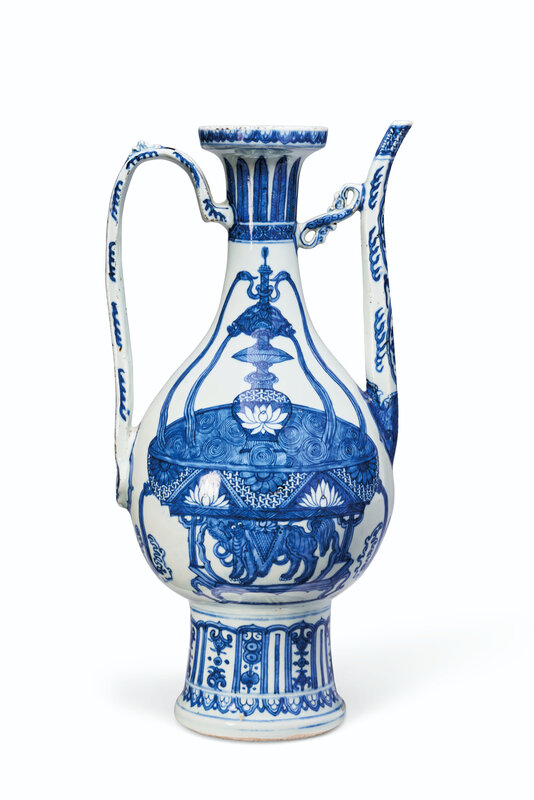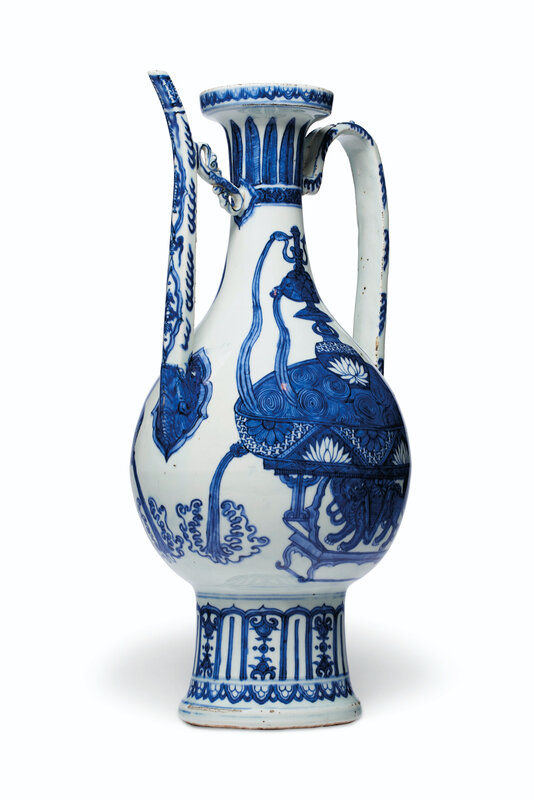Each side of the ewer is decorated in bright shades of underglaze cobalt blue with a fountain with a pair of central animal heads and upper interlocking bird heads, both spouting water into a circular basin, which is supported on the back of a qilin, all between decorative borders on the spreading neck and tall, pedestal foot, cloth box.
Provenance: Millon Jutheau, Paris, 25 June 1980.
The Lenora and Walter F. Brown Collection, San Antonio, Texas.
Exhibited: Houston, The Museum of Fine Arts, Houston, The Private Eye: Selected Works from Collections of Friends of the Museum of Fine Arts, Houston, 11 June-13 August 1989.
On loan, San Antonio Museum of Art, February 2003-March 2004.
Note: The origin of the design of this ewer, and others like it, has been the subject of much research. The form and decoration represent a combination of a variety of cultural influences from China, Europe, and the Middle East. The shape is inspired by Near Eastern brass pitchers, but the decoration may relate to that found on contemporaneous majolica wares or in paintings. The design of many of these ewers also often incorporates elements that are more commonly found in Chinese material culture, such as the qilin crouched beneath the fountain, the flames on the spout and handle, and the lappet decoration on the foot and mouth.
A similar blue and white 'magic fountain’ ewer, but with waves around the foot rather than inverted lappets, is illustrated by Jessica Harrison-Hall in Catalogue of Late Yuan and Ming Ceramics in the British Museum, London, 2001, p. 221, no. 9:10. Harrison-Hall suggests that ewers of this design may have been commissioned by Jesuits who lived in Macao from the mid-sixteenth century, and some were involved in the Chinese porcelain industry. According to Linda Rosenfeld Shulsky ('The Fountain Ewers: An Explanation for the Motif’, Museum of Far Eastern Antiquities Bulletin, no. 67, Stockholm, 1995, pp. 49-78), there are a number of aspects of Christian iconography which could account for the appearance of fountains on these ewers, such as depictions of the Virgin Mary Tota Pulchra, which show 'the Virgin surrounded by symbols of her immaculacy taken from the Song of Solomon' including fountains similar to those on the ewers. Furthermore, it is known that ewers of this design were sent to Europe for export as early as the seventeenth century, as depictions of them are present in the paintings of the time.
In addition to being sent to Europe in the seventeenth century, ewers of this design were also sent to the Near East by the same time period. 'Magic fountain' ewers can also be found in the collection of the Topkapi Saray, Istanbul and in the collection of the Ardebil Shrine, Tehran, bearing Near Eastern metal mounts which date to the seventeenth century. An example with metal mounts are illustrated by Ayers and Krahl in Chinese Ceramics in the Topkapi Saray Museum Istanbul, vol. 2, Yuan and Ming Dynasty Porcelains, London, 1986, p. 655, no. 1015, which has a band of waves around the spreading foot and a san character or trigram. Other examples with metal mounts are illustrated ibid, nos. 1013, 1014, and 1016, with alternative decoration around the base and trigrams or hares on the base. See, also, the metal-mounted ewer in the Musée Guimet, Paris, illustrated in Oriental Ceramics, The World's Great Collections, Tokyo, New York and San Francisco, 1981, vol. 7, fig. 80. Related ewers with slightly different decoration and alternative four-character auspicious marks or apocryphal reign marks are illustrated in Oriental Ceramics, The World's Great Collections, vol. 3, fig. 200, from the Museum Pusat, Jakarta, and vol. 4, col. pl. 61, from the Iran Bastan Museum, Tehran.
Christie's. Important Chinese Ceramics and Works of Art, New York, 25 September 2020

/https%3A%2F%2Fprofilepics.canalblog.com%2Fprofilepics%2F1%2F0%2F100183.jpg)
/https%3A%2F%2Fstorage.canalblog.com%2F03%2F02%2F119589%2F96711876_o.jpg)
/https%3A%2F%2Fstorage.canalblog.com%2F11%2F31%2F119589%2F94773502_o.jpg)
/https%3A%2F%2Fstorage.canalblog.com%2F20%2F83%2F119589%2F94772815_o.jpg)
/https%3A%2F%2Fstorage.canalblog.com%2F26%2F72%2F119589%2F75604929_o.jpg)
/https%3A%2F%2Fstorage.canalblog.com%2F59%2F60%2F119589%2F26458628_o.jpg)






/image%2F1371349%2F20240416%2Fob_2a8420_437713933-1652609748842371-16764302136.jpg)
/image%2F1371349%2F20240414%2Fob_83ee65_2024-nyr-22642-0954-000-a-blue-and-whi.jpg)
/image%2F1371349%2F20240414%2Fob_15808c_2024-nyr-22642-0953-000-a-blue-and-whi.jpg)
/image%2F1371349%2F20240414%2Fob_e54295_2024-nyr-22642-0952-000-a-rare-blue-an.jpg)